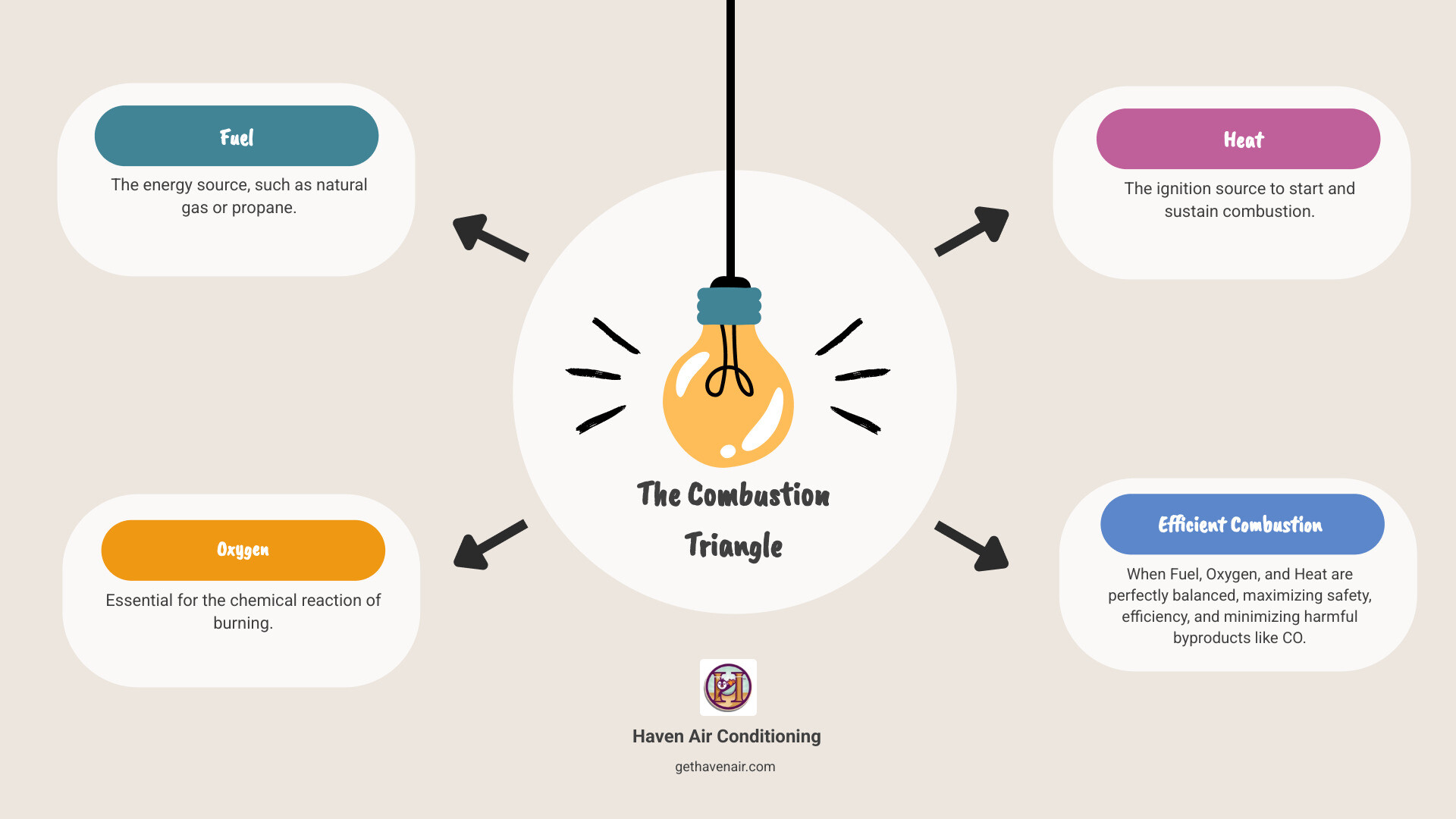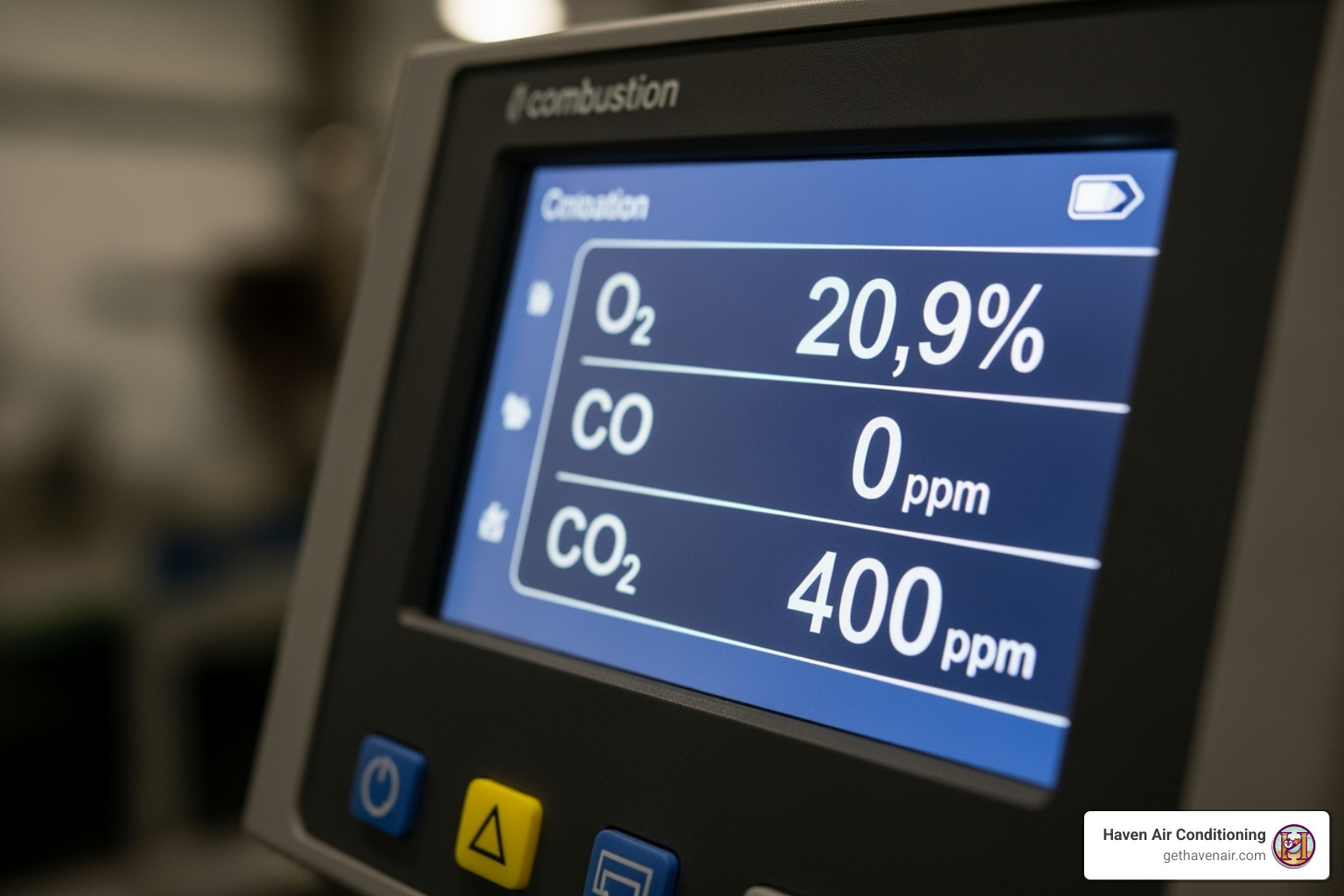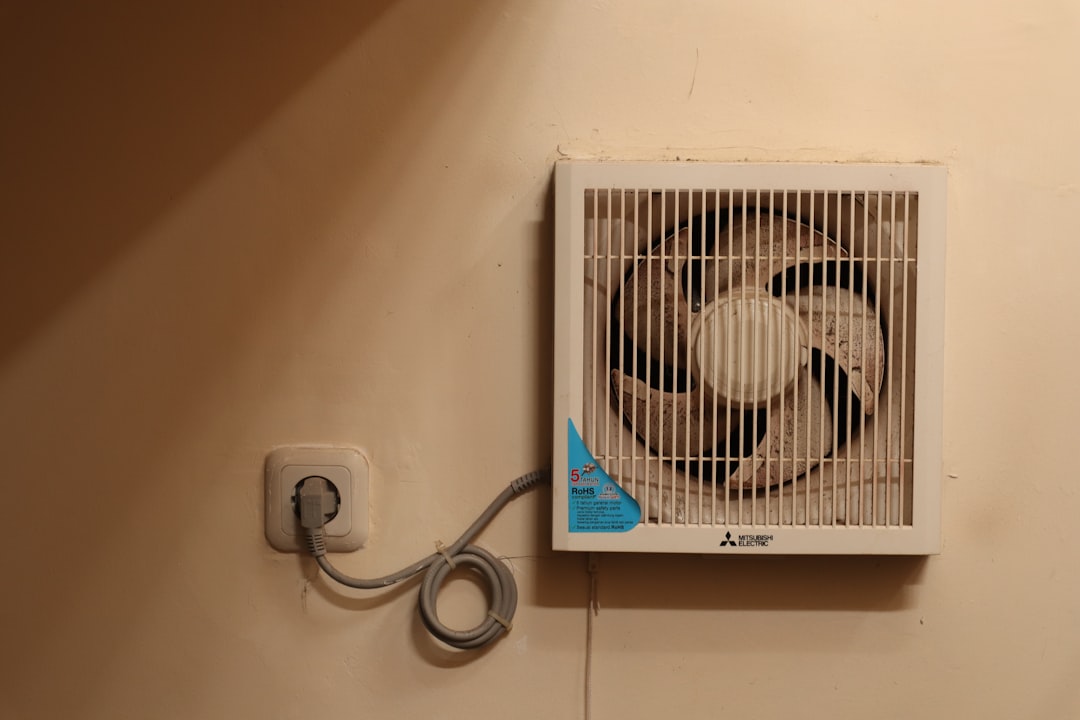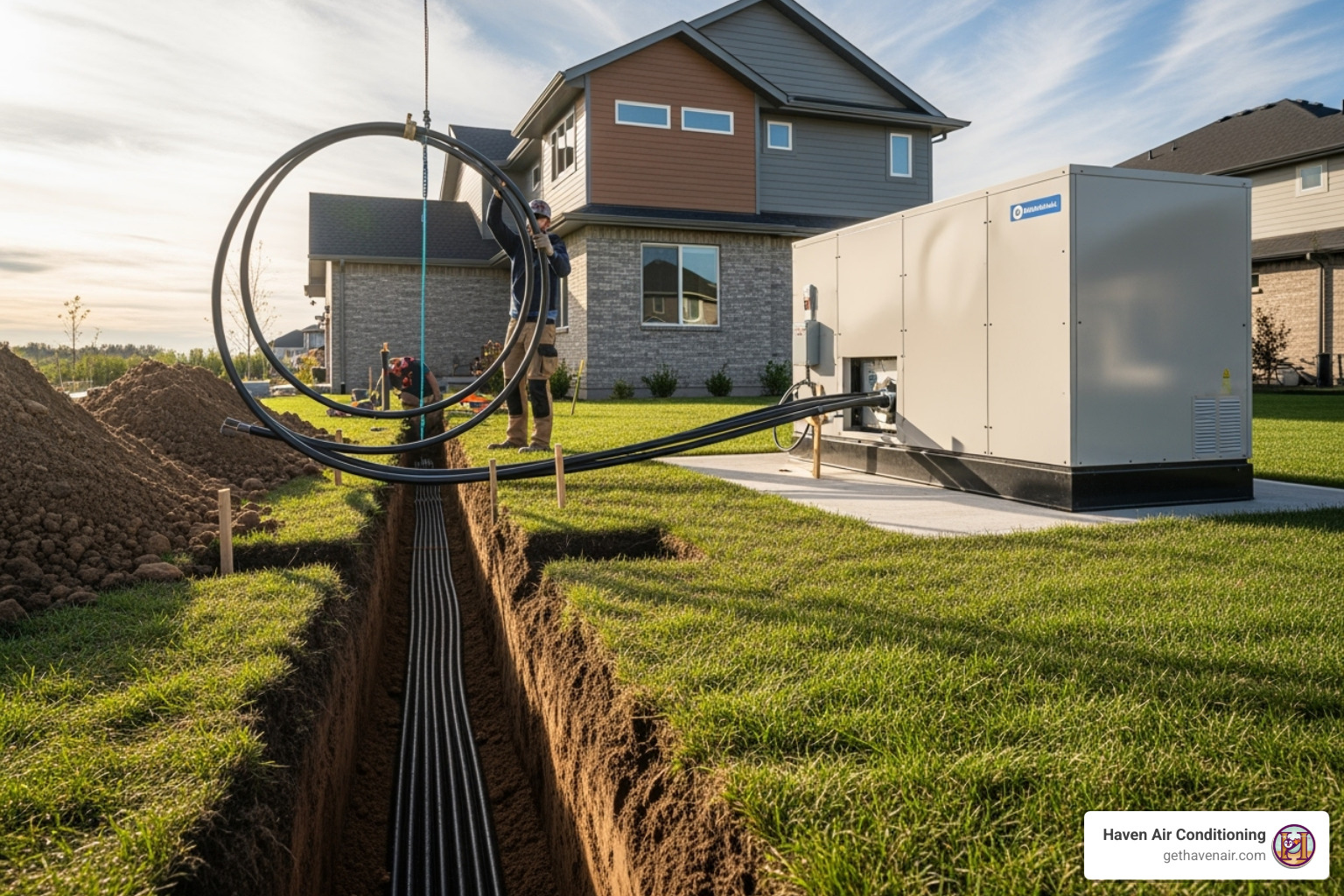Why Your Furnace’s “Breathing” Matters More Than You Think
Combustion analysis service is a detailed testing process that measures how efficiently your furnace, boiler, or water heater burns fuel—and whether it’s creating dangerous gases like carbon monoxide in the process. For homeowners in Orange County, this isn’t just about saving money on energy bills; it’s about keeping your family safe from invisible hazards that a standard visual inspection can’t catch.
What You Need to Know About Combustion Analysis Service:
- What it measures: Oxygen (O₂), carbon dioxide (CO₂), carbon monoxide (CO), flue gas temperature, and air-to-fuel ratios
- Why it matters: Detects dangerous CO leaks, improves energy efficiency by up to 30%, and extends your equipment’s lifespan
- Who needs it: Any home with fuel-burning appliances—gas furnaces, boilers, or water heaters
- How often: Annually, especially before winter, or if you notice yellow flames, soot buildup, or increased heating bills
- Not for electric systems: Heat pumps and electric furnaces don’t require combustion testing
Think of it this way: your furnace needs three things to work properly—fuel, oxygen, and heat. When these aren’t balanced, you get incomplete combustion. That means wasted energy, higher bills, and potentially deadly carbon monoxide building up in your home. A combustion analysis is like a blood test for your heating system. It goes beyond what a technician can see with their eyes and delivers real-time data on what’s actually happening inside your equipment.
If you’re dealing with a furnace that’s cycling too often or struggling to keep up, you might need more than just an analysis—learn more about furnace repair and replacement options in Anaheim, or schedule a comprehensive HVAC maintenance visit to catch problems before they become emergencies.
What Is Combustion Analysis and Why Is It Crucial for Your Furnace?
Here’s what most homeowners don’t realize: your furnace isn’t just heating your home—it’s conducting a controlled chemical reaction every single day. When everything’s working right, fuel and oxygen combine perfectly to create warmth, with only water vapor and carbon dioxide as byproducts. But when that balance is off, even slightly, things can go dangerously wrong.
That’s where combustion analysis service comes in. This isn’t about checking if your furnace turns on or if the filter looks dirty. It’s a scientific assessment that measures exactly what’s happening during the burning process. We’re talking about a potent technique that reveals the invisible—the actual chemical composition of your furnace’s exhaust gases.
The primary purpose is straightforward: keep your family safe and your energy bills reasonable. A visual inspection can spot a cracked heat exchanger or a loose wire, but it can’t tell you if your furnace is silently producing carbon monoxide or wasting 20% of your fuel dollars by burning inefficiently. That requires real data from specialized equipment.
When combustion is complete, your natural gas or propane furnace produces mostly carbon dioxide and water vapor—harmless stuff that vents safely outside. But incomplete combustion tells a different story. Without enough oxygen, your system starts creating carbon monoxide (CO), unburned hydrocarbons, and nitrogen oxides. These aren’t abstract environmental concerns. They’re immediate threats that can make your family sick or worse.
This analysis applies to any fuel-burning appliance in your home. Furnaces are the most common, but we also test boilers that heat your water or warm your floors, and water heaters that run on gas. Even if you have multiple systems, each one burning fuel needs its own assessment because each has its own combustion characteristics.
Beyond the immediate safety concerns, combustion analysis helps with fire safety and environmental monitoring. We can spot conditions that might lead to dangerous flashbacks or improper venting. And by optimizing how your system burns fuel, we’re reducing harmful emissions—which means cleaner air inside your home and a smaller environmental footprint overall.
The Difference Between a Standard Tune-Up and a True Analysis
Let’s be honest: most homeowners don’t know there’s a difference between a tune-up and a combustion analysis. And why would you? They both involve a technician showing up with tools.
Here’s the distinction that matters. A standard tune-up is like your annual doctor’s checkup—we listen, look, test basic functions, change filters, tighten connections, and make sure everything seems to be working. It’s valuable maintenance that every system needs.
But a combustion analysis service is more like getting bloodwork done. We’re measuring what’s actually happening inside your system at a molecular level. While a visual inspection might show us that your burner flames look okay, only a digital analyzer can tell us that your air-to-fuel ratio is off by 15%, causing incomplete combustion and wasting money on every heating cycle.
This data-driven assessment gives us the precision to make adjustments that a standard tune-up simply can’t achieve. We’re not guessing or relying on factory settings from years ago. We’re optimizing your HVAC system performance based on how your specific furnace is burning fuel right now, in your home, with your gas supply and your venting configuration.
That precision is what prevents breakdowns. When we catch efficiency problems early—before they turn into component failures—you avoid those emergency repair calls in the middle of a cold January night. It’s the difference between reactive maintenance and truly proactive care.
Key Elements Measured in Your Home’s System
When we perform a combustion analysis service, we’re essentially giving your furnace a complete diagnostic workup. We insert a specialized probe into your flue pipe and let our digital analyzer sample the exhaust gases while your system runs. It’s non-invasive, quick, and incredibly revealing.
For homes using natural gas or propane, we’re tracking four critical measurements that tell us everything we need to know about your furnace’s health.
Oxygen (O₂) levels reveal whether your combustion chamber is getting the right amount of air. Think of it like your car’s engine—too much air and you’re running lean, sending heat straight up the chimney instead of into your home. Too little air and you get incomplete combustion, which creates carbon monoxide. We’re looking for that Goldilocks zone where everything’s just right.
Carbon Monoxide (CO) is the measurement that keeps us up at night if we find liftd levels. This odorless, colorless gas is produced when fuel doesn’t burn completely. Even small amounts can cause headaches, dizziness, and flu-like symptoms. Higher concentrations? They’re deadly. Our analyzers can detect CO in parts per million, so we catch problems before they become emergencies.
Carbon Dioxide (CO₂) might sound scary, but it’s actually a sign of good combustion when we see it in the right amounts. Higher CO₂ levels (within safe ranges) typically mean your furnace is burning fuel efficiently and completely. We use this reading alongside oxygen levels to calculate your exact combustion efficiency.
Flue gas temperature tells us how much heat is escaping up your chimney instead of warming your home. If this number is too high, you’re literally watching your heating dollars float away. It’s one of the clearest indicators of poor heat transfer efficiency and often points to problems like dirty heat exchangers or improper airflow.
These four measurements work together like pieces of a puzzle. Individually, they’re useful. Together, they give us a complete picture of exactly what’s happening inside your furnace—and what we need to adjust to keep you safe and comfortable.
The Anatomy of a Professional Combustion Analysis Service
When you schedule a combustion analysis service, you’re getting much more than someone just showing up with a gadget. This is a detailed, methodical process performed by technicians who’ve earned their stripes—literally. Our team members hold NATE certifications and EPA credentials, which means they’ve passed rigorous exams and demonstrated real expertise in HVAC diagnostics. They don’t just know how to read the numbers; they understand what those numbers mean for your family’s safety and your wallet.
The difference between a basic service call and a professional combustion analysis is like the difference between checking your pulse and getting a full physical with bloodwork. We’re looking at real-time data from inside your heating system, then using that information to fine-tune your furnace until it’s running at its absolute best. It’s precision work, and it makes all the difference.
The “Vital Signs”: What We Measure for Safety and Efficiency
During your combustion analysis service, we’re checking several critical indicators that tell us whether your furnace is healthy or headed for trouble. The air-to-fuel ratio is our first priority—this is the sweet spot where your furnace burns fuel completely and efficiently. When this ratio is off, you’re looking at incomplete combustion, and that’s where the real problems start.
Incomplete combustion risks are at the top of our safety checklist. This is when your furnace starts producing carbon monoxide instead of burning cleanly. We’re hunting for even trace amounts of CO because this invisible gas doesn’t give second chances.
We also measure heat transfer efficiency by checking your flue gas temperature. If those gases are too hot, it means heat that should be warming your home is escaping up the chimney instead. Nobody wants to pay to heat the outdoors, especially in Orange County where we’re already warm enough most of the year.
Soot buildup around your burner tells us a story too. It’s like seeing smoke signals that say “something’s not right here.” Soot means wasted energy and increased safety risks, and it’s one of the first things our technicians look for during the visual inspection.
Finally, there’s flame color—one of the most telling signs of furnace health. A healthy gas flame should be a steady, crisp blue. If we see yellow or flickering flames, that’s nature’s way of waving a red flag. Yellow flames mean incomplete combustion, which circles us right back to that carbon monoxide danger we’re working so hard to prevent.
The Step-by-Step Process: From Inspection to Fine-Tuning
Our combustion analysis service follows a careful sequence that ensures we catch every detail and make the right adjustments for your specific system.
We always start with an initial visual check before any high-tech equipment comes out. Our technicians walk around your furnace looking for the obvious stuff—soot marks, strange smells, or that telltale yellow flame. This gives us context and helps us know what to expect when we start taking measurements.
Next comes inserting the probe into your furnace’s flue pipe. This specialized probe connects to our digital combustion analyzer and needs to be positioned just right to get accurate readings. We’re sampling the exhaust gases as they leave your system, capturing a real-time snapshot of what’s happening inside.
The analyzer then begins collecting gas samples, actively drawing in the flue gases and measuring them continuously. This isn’t a one-and-done reading—we watch how the levels change and stabilize, which gives us a much clearer picture than a single snapshot ever could.
Analyzing readings is where our technicians’ training really shines. The digital display shows precise measurements of oxygen, carbon monoxide, carbon dioxide, and temperature—often down to one part per million for critical gases like CO. These numbers tell us exactly how your furnace is performing and where it needs help.
Based on what the data reveals, we move to making adjustments. This might mean tweaking the air intake, cleaning components that are affecting combustion, or adjusting gas pressure to achieve that perfect air-to-fuel ratio. Every adjustment is calculated and purposeful—we’re working to minimize CO production, optimize CO₂ levels, and keep as much heat as possible inside your home where it belongs.
Finally, we don’t just pack up and leave. Verifying results means we run the analysis again after making changes to confirm everything is now in the safe and efficient zone. We compare the before-and-after readings to make sure our adjustments hit the mark. Your home deserves nothing less than a heating system that’s operating at its absolute best, and we won’t consider the job done until we’re certain that’s exactly what you’ve got.
The Big Payoffs: Key Benefits of Regular Analysis
When you invest in a regular combustion analysis service, you’re doing something smart for your home that pays dividends in multiple ways. Think of it as quality control for your heating system—just like manufacturers test their products to ensure they’re working perfectly, we’re making sure your furnace is performing at its absolute best. This isn’t just about comfort; it’s about creating long-term reliability and giving you the peace of mind that comes from knowing your home is safe and efficient.
How a Combustion Analysis Service Protects Your Family
Let’s talk about the elephant in the room—or rather, the invisible threat in your home. Carbon monoxide (CO) is one of the most dangerous things your furnace can produce, and it’s particularly scary because it’s completely odorless, colorless, and tasteless. You literally cannot detect it without proper equipment.
Even low levels of CO can make your family sick. The symptoms often mimic the flu—dizziness, headaches, nausea, and fatigue—which means many people don’t realize what’s causing their illness. Higher concentrations can be deadly, and that’s not something we take lightly.
This is where combustion analysis service becomes your family’s guardian. Our testing catches CO production before it becomes a problem. We measure the exact concentration of carbon monoxide in your flue gases, down to parts per million. If we detect any CO leaking into your home instead of being safely vented outside, we can address it immediately.
Speaking of venting, that’s another critical safety element we check. Your furnace needs to properly exhaust all combustion byproducts up and out of your home through the chimney. If the draft isn’t working correctly, those gases can back up into your living space. Our analysis confirms that proper venting is happening, so you can breathe easy knowing your heating system isn’t compromising your indoor air quality.
How a Combustion Analysis Service Boosts Efficiency and Saves Money
Now let’s talk about something equally important but perhaps more immediately noticeable—your wallet. An inefficient furnace is essentially burning money along with your natural gas or propane. When combustion isn’t optimized, your system has to work harder and consume more fuel to deliver the same amount of heat to your home.
Our combustion analysis service identifies exactly where energy is being wasted. Maybe your air-to-fuel ratio is off, causing incomplete combustion. Perhaps too much heat is escaping up your chimney because the flue gas temperature is too high. These are the subtle inefficiencies that can increase your utility bills by 20-30% without you even realizing there’s a problem.
By fine-tuning your system based on real data, we help you start lowering those monthly utility bills immediately. It’s like finding money you didn’t know you were losing. And the savings compound over time—a more efficient furnace means reduced energy waste month after month, heating season after heating season.
There’s another financial benefit that’s less obvious but equally valuable: extending your equipment’s lifespan. A furnace that’s running inefficiently is working harder than it needs to, which means more wear and tear on components. That stress shortens your system’s life and leads to breakdowns. By keeping everything optimized, we help your furnace last years longer, delaying that major expense of a replacement.
And speaking of repairs, catching problems early through regular analysis means preventing costly emergency repairs. When we spot a combustion issue during routine testing, we can address it with a minor adjustment or repair. Wait until that issue causes a breakdown on the coldest night of the year, and you’re looking at a much bigger bill—not to mention a very uncomfortable evening.
Finally, there’s the environmental angle. An optimized furnace doesn’t just save you money; it also produces lower emissions and reduces your home’s carbon footprint. When combustion is complete and efficient, you’re burning less fuel and releasing fewer pollutants into the atmosphere. It’s a small way every Orange County homeowner can contribute to cleaner air for everyone.
The bottom line? Regular combustion analysis is one of those rare services that genuinely delivers multiple benefits at once—safety, savings, longevity, and environmental responsibility. That’s what we call a smart investment in your home.
Frequently Asked Questions About Combustion Analysis
We know that combustion analysis service might sound technical, so let’s tackle some of the most common questions we hear from homeowners throughout Orange County. These answers will help you understand when and why this service matters for your home.
How often should I schedule a combustion analysis?
Here’s our honest recommendation: once a year, every year. Think of it like your annual physical—you wouldn’t skip it just because you feel fine, right? The same logic applies to your furnace.
The best time to schedule your combustion analysis service is before winter hits. You want to know your heating system is ready to handle the cold months ahead, not find a problem on the first chilly night when everyone’s trying to stay warm. This annual testing should be part of your routine maintenance plan, right alongside filter changes and general system checks.
Now, if your furnace is getting up there in years—say, over 15 years old—or if you’ve had recent repairs done, you might want to consider more frequent testing. Older systems can develop issues faster, and it’s worth the peace of mind to check them more often. Better to catch a small problem early than deal with a middle-of-the-night emergency!
What are the signs I might need a combustion analysis?
Your furnace has a way of telling you when something’s not right. Sometimes it whispers, sometimes it shouts. Here are the warning signs you shouldn’t ignore:
If your heating bills have suddenly jumped without explanation, your furnace might be working overtime to compensate for inefficiency. That’s money literally going up your chimney. Yellow or flickering flames are another red flag—remember, we want that steady blue flame. Yellow means incomplete combustion, and that’s when carbon monoxide becomes a real concern.
Have you noticed soot buildup around your furnace? That black, powdery residue is your system’s way of saying “I’m not burning fuel properly.” Similarly, any unusual odors coming from your heating system deserve immediate attention, especially if you detect even a faint gas smell.
Here’s where things get serious: if anyone in your household experiences frequent headaches or flu-like symptoms that seem to appear when the furnace is running, don’t wait. These symptoms—dizziness, nausea, fatigue—are classic signs of carbon monoxide exposure. Get everyone out of the house, seek medical attention, and then call us immediately for an emergency inspection.
Your body and your furnace are both trying to tell you something. Listen to them.
Does my electric furnace or heat pump need a combustion analysis?
Great question, and the answer is actually pretty straightforward: no, they don’t. Here’s why that makes perfect sense.
A combustion analysis service is designed specifically for fuel-burning appliances—systems that use natural gas, propane, or oil. Electric furnaces and heat pumps work on completely different principles. Electric furnaces use electrical resistance to generate heat (kind of like a giant toaster), while heat pumps move heat from one place to another using refrigerant and electricity.
Since there’s no fuel being burned, there’s no combustion happening at all. That means no combustion byproducts, no carbon monoxide risk, and no need for the specialized testing we’ve been discussing. It’s like asking if your electric car needs an oil change—the question just doesn’t apply because the technology works differently.
That said, electric systems and heat pumps still need regular maintenance to keep them running efficiently. They have their own set of components that need attention, from electrical connections to refrigerant levels. We provide comprehensive maintenance for all types of heating systems across Orange County, so whether you’re burning fuel or running on electricity, we’ve got you covered.
Keep Your Home Safe and Efficient with Expert Analysis
Your furnace is the heart of your home’s comfort during those cooler Orange County evenings. We’ve walked through exactly what a combustion analysis service does—from measuring those critical oxygen and carbon monoxide levels to fine-tuning your system for peak performance. We’ve talked about how it protects your family from invisible dangers like CO poisoning, and how it can slash your energy bills while adding years to your equipment’s life.
The bottom line? This isn’t just another maintenance checkbox. It’s about making sure your family breathes clean air, your heating system runs at its best, and you’re not throwing money out the window (or up the chimney) every month.
At Haven Air Conditioning, we’ve built our reputation on taking care of homes throughout the Greater Orange County Area with the kind of attention to detail that turns first-time customers into lifelong friends. Our certified technicians don’t just show up with equipment—they show up with expertise, a friendly attitude, and a genuine commitment to your home’s safety and efficiency.
We know you have choices when it comes to HVAC service. What sets us apart is simple: we treat your home like it’s our own. We take the time to explain what we’re doing, answer your questions (even the ones you didn’t know you had), and make sure you feel confident about your heating system’s performance.
Your furnace deserves more than just a quick glance and a filter change. It deserves a thorough health check that ensures it’s burning clean, running efficiently, and keeping your family safe all winter long. Schedule your HVAC maintenance today and let us show you what exceptional service really means. Your home—and your peace of mind—are worth it.









